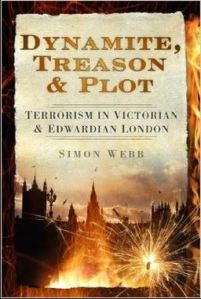Webb, Simon. Dynamite, Treason and Plot: Terrorism in Victorian and Edwardian London. Stroud: The History Press, 2012.
There is a tendency today to see terrorism as some modern aberration, something that has arisen in recent years and might with luck fade away in time. This is unlikely. Terrorism of different sorts has been a constant backdrop in British history for centuries; it is likely to remain so for centuries to come. The notion that increased vigilance on the part of the public, combined with wise and good laws passed by Parliament, might one day defeat terrorism and usher in a peaceful era, where nobody needs to worry about bombs and assassinations, is a chimera.
Webb, p.151
As far as most people are concerned, Guy Fawke’s plot, the IRA bombings of the 1970s and 7/7 are probably the only examples of terrorism in London. In Dynamite, Treason and Plot: Terrorism in Victorian and Edwardian London, Simon Webb sets out to correct that misconception. From the Clerkenwell Outrage, where 12 people were killed in a Fenian prison break gone wrong; to the Tottenham Outrage (not every event is known as an Outrage, I promise!), a chase that lasted several hours and involved the hijacking of a tram and a milk cart, the stories Webb tells range from the horrific to the downright farcical.
Arguably the biggest strength of Dynamite, Treason and Plot is the emphasis on continuity. Humans have a tendency to believe that everything that happens is new, that the problems faced by modern society are unique to our time. Webb proves the inaccuracy of this belief, demonstrating that not only terrorism, but also immigration and xenophobia, are issues that the people of London have been grappling with for centuries. Irish, Jewish, and more recently Muslim; many minorities have been the subject of fear and discrimination in the city, and terrorism has frequently exacerbated the tensions.
Another of the strengths of Dynamite, Treason and Plot is Webb’s approach to terrorism itself. Webb doesn’t condemn the terrorists he describes outright, but neither does he glorify them. The first chapter of the book is devoted to discussion of the theories and motivations behind terrorism. It is not necessarily the mindless, monstrous violence which it is often portrayed as-there are particular reasons why people choose to resort to terrorism-and Webb takes them into account. Terrorism is an emotive subject, difficult to deal with in a sensitive and balanced way, but I think Webb does a good job of this.
Webb’s writing style can be repetitive; he frequently makes the same point twice in quick succession, and he often says how it was “nothing short of a miracle” that more people weren’t killed or injured in the events he recounts. He makes assertions, making a point without providing any supporting evidence, and often overlooks some of the historical controversies and debates. For example, in the chapter about the Suffragettes, Webb mentions the alleged plot to assassinate David Lloyd George by the Wheeldon family. In Dynamite, Treason and Plot it appears there is no doubt that that is what actually happened, but in To End all Wars by Adam Hochschild the event appears much more complicated. Hochschild suggests that the whole thing may have been a set-up, the plot concocted by the government to harm the opposition to the First World War, of which the Wheeldon family was a part. Whatever the truth, Webb completely ignores the debate, and as such misses out on some of the nuances of the story.
Despite the shortfalls I think Dynamite, Treason and Plot is well worth a read. It is an engaging read that deals with some of London’s darker, overlooked history. Webb puts terrorist into political and social context, rather than treating it as an isolated and inexplicable phenomenon to be instantly condemned.



